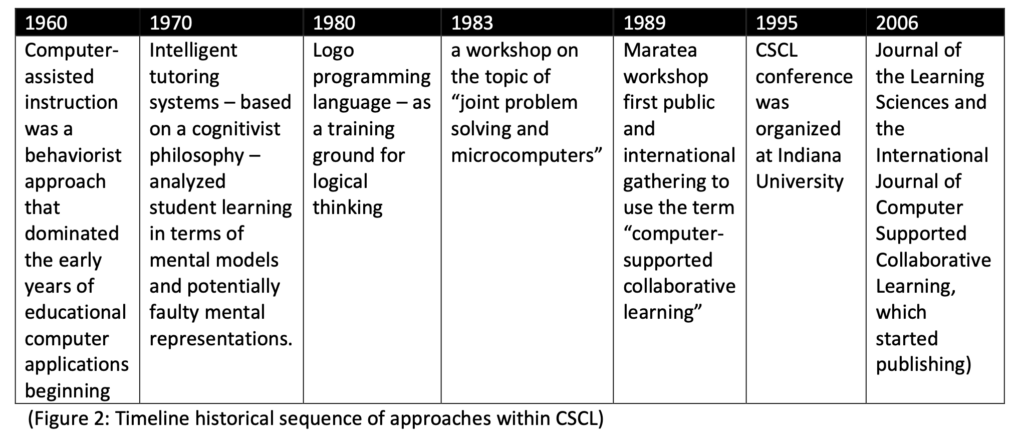Chapter 20, “Computer-Supported Collaborative Learning” (CSCL), by Gerry Stahl, Timothy Koschmann, and Daniel Suthers, was published in 2022 in the Cambridge Handbook of the Learning Sciences, explores the transformative vision of CSCL in education. It provides a comprehensive understanding of how technology can enhance collaborative learning. The chapter is highly relevant to my current role as a learning technology specialist at the post-secondary institution, where I integrate collaborative learning techniques into the online curriculum design and provide strategies for instructors to prepare and deliver online courses effectively.
Stahl et al. (2022) begin by arguing that traditional online tools like Zoom and Blackboard, which were not originally designed for educational purposes, are insufficient for effective pedagogy. In contrast, CSCL supports collaboration that builds beyond individual ideas and isolated facts to create shared knowledge” (p.406). It moves beyond traditional individual-focused instructional methods and leverages collaboration to foster shared knowledge creation. Key conceptualizations of CSCL include collaborative knowledge building, dialogic interaction, intersubjective meaning-making, and group cognition, which are crucial for designing effective online learning environments.
CSCL within Education
CSCL within Education “bring[s] students together across time and space to collaborate – both asynchronously and in real-time, remotely and face-to-face” (p.407). However, “[it] is often conflated with online learning” (p.407), which involves teaching through computer networks. People sometimes mistakenly believe that classroom content can be simply digitized and shared with many students without much ongoing teacher involvement (Stahl et al., 2022). Without the teaching presence, research has found it difficult to engage students and facilitate their cognitive development in an online learning environment (Wang & Stein, 2021). With this in mind, my research focuses on professional development/training for online instructors since “teachers are key to determining how any intervention is realized and sustained in practice” (Fishman, Chan, & Davis, 2022, p. 619). Developing teaching presence involves the design and instruction of learning processes and resources to promote students’ social and cognitive presence (Wang & Stein, 2021).
The Historical Emergency of CSCL
The historical emergence of CSCL is traced from early workshops to a global community, differentiating it from earlier computer-assisted instruction, intelligent tutoring systems, and programming. The shift from individual to group-focused learning is emphasized, viewing learning as a social process of shared meaning-making rather than an individual cognitive function (Stahl, Koschmann, and Suthers, 2022). [See Figure 1: CSCL Past and Now; Figure 2: Timeline of the historical sequence of approaches within CSCL]. Reviewing the historical sequence of approaches with CSCL reveals a significant shift in instructors’ roles from knowledge providers to active collaborators in shaping meaning. This change motivates me to investigate how instructors can facilitate student collaboration and create a dynamic, interactive learning atmosphere. I am particularly interested in analyzing the perceptions of both instructors and students regarding the effectiveness of promoting teaching presence to enhance learning in an online asynchronous course, with a specific focus on discussion forums.


The Interplay of Learning and Technology in CSCL
Stahl et al. (2022) highlight the significant connection between learning and technology in CSCL and advocate for the development of technologies that support intersubjective meaning-making. Prioritizing technologies that facilitate intersubjective meaning-making enriches collaborative learning experiences through various methodological approaches, including experimental studies, descriptive case studies, and design-based research (Stahl et al., 2022). By stressing the importance of multidisciplinary collaboration, this approach can help me integrate insights from diverse fields, resulting in more comprehensive and engaging online courses that better address the needs of diverse learners.
CSCL Research in the Future
Stahl et al. (2022) conclude by outlining future directions for CSCL research, emphasizing the importance of focusing on “group practices and intersubjective meaning-making to support collaborative learning” (p.423). They provide a visionary framework for understanding and implementing collaborative learning in online environments, addressing the challenges and potentials of integrating technology into education. This forward-looking perspective can inform my research by identifying emerging trends and methodologies in the design of online learning, allowing me to consider how I can incorporate these values and frameworks into my work to help our online instructors create meaningful online learning environments.
Reference
Stahl, G., Koschmann, T., & Suthers, D. (2022). Computer-Supported Collaborative Learning. In R. K. Sawyer (Ed.), The Cambridge Handbook of the Learning Sciences (3rd ed., pp. 406–427). Cambridge University Press. https://doi.org/10.1017/9781108888295.025
Wang, Y., & Stein, D. (2021). Effects of online teaching presence on students’ cognitive conflict and engagement. Distance Education, 42(4), 547–566. https://doi.org/10.1080/01587919.2021.1987837
Fishman, B. J., Chan, C. K. K., & Davis, E. A. (2022). Advances in Teacher Learning Research in the Learning Sciences. In R. K. Sawyer (Ed.), The Cambridge Handbook of the Learning Sciences (3rd ed., pp. 619–637). Cambridge University Press. https://doi.org/10.1017/9781108888295.038
Leave a Reply